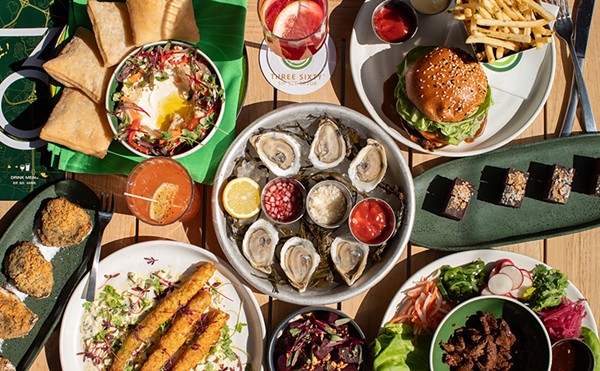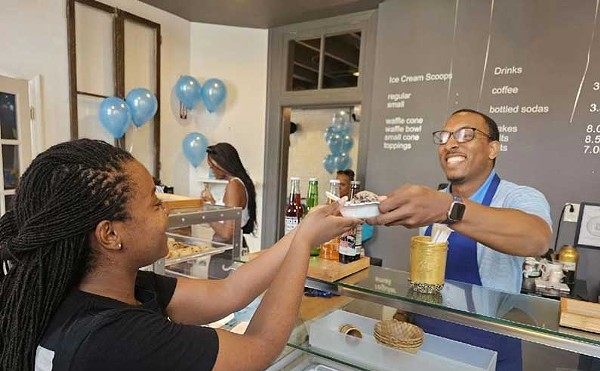We were duly impressed with what we found: a truly cosmopolitan French bistro on a charming tree-lined street, with all kinds of characters marching by the windows to add to the flavor. There was classic French stuff on the menu, not daring, but hey, this was the heyday of the fern bar, so even the signature beef Wellington was a tad risqué.
Over the years, Balaban's became my show-off restaurant: Show off for a first date. Show off the hidden treasures of St. Louis to friends old and new, including one memorable meal with the later-controversial psychologist Bruno Bettelheim, to whom I'd been assigned as celebrity babysitter when he came to speak at St. Louis University. And now, fittingly, show off the fabulous love of my life, my wife of 12 years, as we sit and nibble duck and crab and dumplings and snapper and lemongrass-flavored crème brûlée in the pink-tinged light under the giant Campari poster.
Returning after an absence of way too many years, we found that Balaban's still encapsulates everything that is good and noble about dining out in St. Louis. You can indulge yourself inside, in the dining room, or you can have a satisfying but more casual meal out in the enclosed sidewalk cafe. Either way, the place has managed to retain the same sense of vibrancy and newness that it had when it opened 27 years ago -- partially as a result of the primal energy of the surrounding neighborhood, but mostly because of the high standards and ongoing culinary curiosity of the current owners: Tom Flynn, Steve McIntyre (who bought the place in 1986) and chef David Timney (who became a partner in 1993).
We ate in both the dining room and the cafe on a couple of recent visits and, aside from one matter of taste on one of the more "out there" combinations, left the place pretty close to giddy on each occasion.
Although only separated by a windowed wall, the dichotomy of the atmosphere between the two sections was punctuated by the chummier approach of our sidewalk-cafe server, as well as the physical extroversion of the space and its view of the character (and characters) of the neighborhood. Conversely, indoors we were served by a well-choreographed team of two, and the exposed-brick archways, hardwood floors and single iris on each table kept the focus much more centered right at the table.
Seafood predominates on both menus, and what Timney did with a piece of snapper for our meal in the inside dining room showed a fine understanding of diverse influences (if he has to label it, he calls his style "American eclectic"), in this case a combination of Southwestern chile-roasting with an ocean fish. Chiles that add hot for hot's sake are largely wasted, but Timney's poblano aioli relied much more on a smokiness and just a hint of fruit up front, with most of the spice coming on the finish, accompanied by garnish of shredded blue-corn chips to soften the fire if need be.
Balaban's early reputation was so inextricably linked with the beef Wellington that the restaurant started viewing the dish with as much joy as Napoleon must have reflected on the battle of Waterloo, even to the point of running a humorous ad campaign pointing out that the menu was a bit broader than that single dish. Therefore, in good double-reverse fashion, we ordered it, and with beef back in favor these days, it truly is a dish that every good gourmet and gourmand should try at least once. A beef fillet is topped with a light coating of house-made paté and baked inside a pastry shell with a dotting of raisins for an added touch of rummy sweetness; shredded carrots and green beans in the style of haricots verts are served on the side. The pastry is at once a crispy counterpoint and a sponge for the juices, and the baking approach gives the meat a slightly different cooked texture than one might expect from a fillet. (For the record, the Wellington and another "indoor" menu item, the duckling, were also offered to us when we ate out in the cafe.)
For dessert, the quartet of crèmes brûlées was stunning, flavored with almond, coconut, orange and, in a clear case of risk being rewarded, lemongrass, which resulted in what I could most closely describe as a sweet, oniony tartness to balance the creamy custard and the sour, pseudo-citrus bite.
Outside, the food and presentation took on a more pronounced Asian influence, providing our waiter with an opportunity to practice his standup: "Do you guys know how to use chopsticks? Good, 'cause there's going to be a test later." Appetizers of shrimp dumplings and the "Japanese box" allowed us to show off our dexterity on the 'sticks. The dumplings arrived in a miniature bamboo steamer over a soy-and-ginger sauce; the "box" was more of an open pyramid than a box, featuring successive shelves of eggplant-and-shrimp stir-fry, pad thai noodles, a spring roll and tuna tartare. Across all of these elements -- especially those with noodles or noodle casings -- the freshness and doneness levels were uniformly perfect.
For entrees, we went basic with a sirloin steak and funky with duck breast over soba noodles. In the case of the soba noodles, I thought that the addition of dried blueberries put the dish a little over the top, providing a level of sweetness beyond what would be a good complement for the earthiness of the wheat noodles and the full-bodied flavor of the duck. It wasn't off-putting; rather, it just wasn't a balance that suited me, although the thick slices of cross-hatched, medium-rare duck were outstanding. The steak was an ideal sidewalk-bistro dish, a hearty 12-ounce cut with finely shredded onions strewn across the top and around the sides of roasted pepper, carrots and snow peas that certainly must have preferred to be called mange-tout in this particular environment.
The wine list is lengthy and exceptional, but even more exceptional were the extra knowledge and effort exhibited by our waitress, who quizzed us at length on our preferences for oakiness, dryness and several other factors in helping us choose what to drink and then came up with several potential matches.
There are pay parking lots on Euclid and McPherson avenues, but do yourself a favor and cruise for an on-street spot a couple of blocks in any direction, which will afford you the benefit of a brisk stroll through one of the most distinctive neighborhoods in America. Walking back to our car after our meals, the memories just kept on coming: the Post-Dispatch strike-paper newsroom; late nights at Duff's listening to sometime-RFT-scribe Tom McDermott on the piano; antiques at Pete Rothschild's; flowers from Jon Prel; chocolates at Bissinger's; sitting around the Europa with the cast and crew of City Players after the latest of their dozens of world premieres. And throughout it all, dates, brunches, Bastille Days, power lunches, overcrowded bar chats, spiked coffees and other delights at the restaurant at the heart of it all. Vive la CWE! Vive Balaban's!
BALABAN'S, 405 N. Euclid Ave., 361-8085. Hours (the dining room and cafe have different hours; call for confirmation): lunch, 11 a.m.-2:30 p.m. Mon.-Sat.; dinner, 6-10:30 p.m. Mon.-Thu., 5:30-11:30 p.m. Fri. and Sat., 5-10 p.m. Sun.; brunch, 10 a.m.-3 p.m. Sun. Cafe entrees: $9.95-$16.95. Restaurant entrees: $15.95-$22.95.





